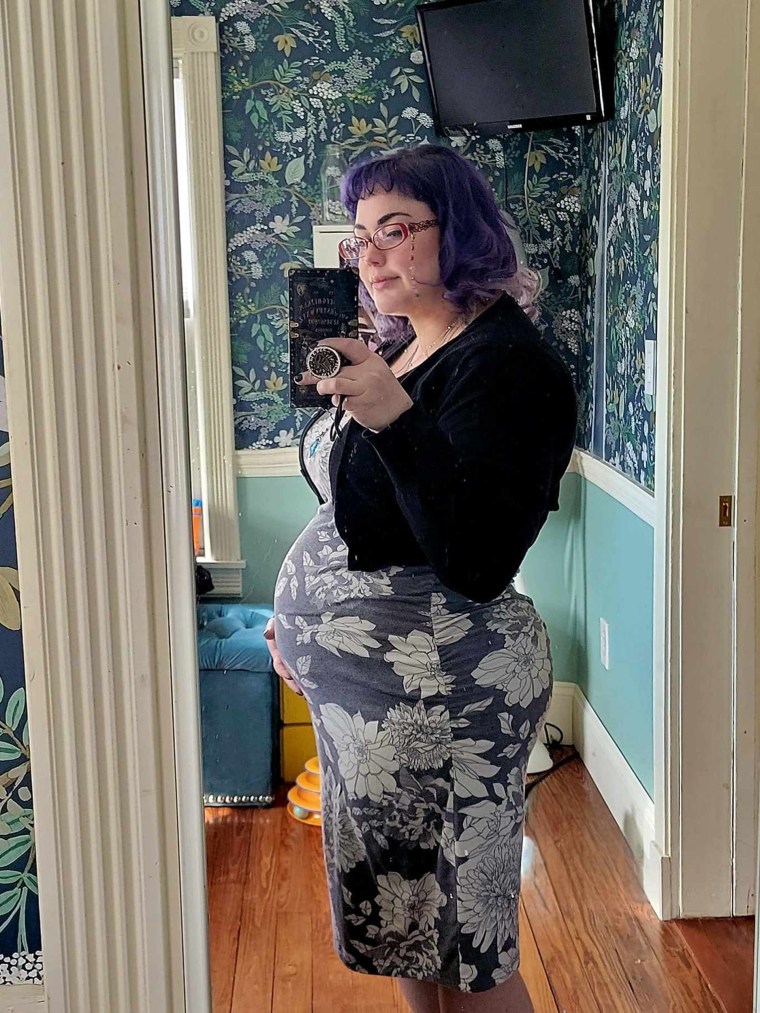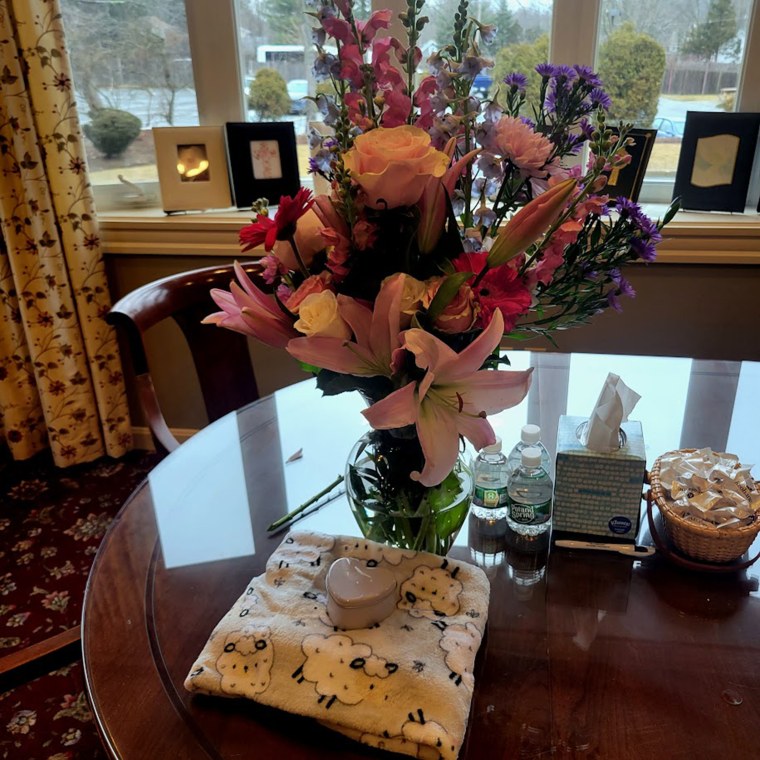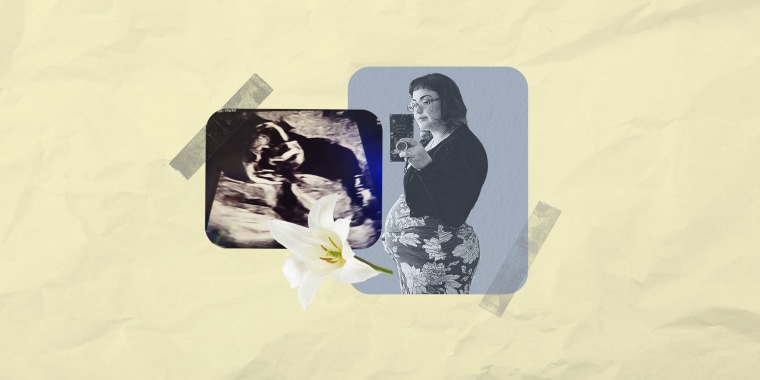Warning: This personal essay discusses failed fertility treatments and mentions late-term miscarriage. Please read with caution, especially if you or a loved one is currently experiencing infertility or fertility treatments of any kind.
April 21-27 is National Infertility Awareness Week. All week, TODAY will be sharing stories to raise awareness of what it is like to experience infertility.
In the infertility community, toxic positivity reigns supreme, and the words “hope” and “miracle” are carelessly tossed around — as if they have real power. Do I sound cynical? Perhaps I am. But I don’t think I’m wrong, either.
For many people, empty promises like “it only takes one” seem to help them cope with the trauma of infertility, but I never found them helpful. Three years, five egg retrievals, 10 embryo transfers, 19 embryos and $165,000 into my in vitro fertilization journey, words like “hope” and promises like “it only takes one” feel like a slap in the face.
I didn’t plan on doing IVF. When I first decided to become a single mother by choice, I thought I would adopt. But adoption is extremely cost-prohibitive, and the restrictions and application process seemed to me impossible for a single woman of average means. Then I looked into fostering, but I learned quickly that to foster, you need to meet specific child-proofing safety standards, even for a teenager. My house was built in 1900, and there were structural concerns — the stairs were too steep and not deep enough, for example — that made fostering a no-go, too.
It seemed to me that having my own biological child was my only viable option. The next step was to see a fertility specialist and find out what my options were. Just a few weeks before my scheduled appointment, the news of COVID-19 broke, and everything shut down. I had no idea when I would get the chance to see a doctor, so I decided to try ICI (intracervical insemination) at home to see if I could get pregnant without waiting for the doctors. It’s pretty common among LGBTQ folks to try ICI before moving onto doctor-assisted fertility treatments, and I found a sperm donor through an app that connects LGBTQ people with donors.
Unfortunately, after a year and five tries, I had three chemical pregnancies and no baby. The clinics had reopened by then, so I made a new appointment, and drove into Boston with Hope by my side.
My IVF journey started rocky. I suppose that should have been a sign of things to come.
Insurance denied me coverage because I couldn't prove that I'd been having sex (with a man) for a year without getting pregnant. I couldn’t afford to pay the amount of money local hospitals wanted out of pocket without insurance, so I sold my house, moved back home and found a low-cost clinic in New York, about a 3.5-hour drive from where I live.
Still, I had Hope.
They warn you that IVF can take a few cycles before it can work. You go in thinking you are prepared for that eventuality, but nothing can prepare you for the first failed transfer. “Let’s get you pregnant!” the doctors say cheerfully as you lie on the table, holding your breath against the pain of the speculum while you watch the ultrasound machine. They instill Hope with their positivity. At home, you look up when your due date will be. You think about what kind of birthday parties your child will have.
Then, two weeks later, your heart sinks as you stare at the results of your pregnancy test. “HCG (Quantitative) Value < 0.”
Even in the online support groups, they don’t tell you that it may never work. “Don’t give up,” people say. “It’ll happen for you. It only takes one.”
But for me, that was never true. I finally got pregnant after four embryo transfers. I transferred two embryos on that fourth attempt, and though I lost one at 7 weeks, the second held strong. I named him Lawrence. I set up his nursery. My sisters had started planning my baby shower. I made him a Christmas stocking, and my father bought him a stuffed bear from FAO Schwarz. I sang to him and whispered promises every night as I fell asleep.

Then, at my 17-week scan, the words, “I can’t find a heartbeat” sent my world reeling out of focus.
“Wait to announce until after twelve weeks,” is the advice everyone gives. “Then you know you’re safe.”
But they’re wrong. There is no safe. No one warns you that there is no such thing as “safe.” All my hopes and dreams came crashing down around me as I listened to the doctor explain that I’d need a D&C (dilatation and curettage), or else I could go septic. Nothing was ever the same again when I woke up from surgery, and my rounded belly was flat once more.
No one prepares you for the conversation about what to do with your baby’s remains. No one prepared me for the moment when I broke down sobbing after the funeral director opened the door and asked, “Are you Lawrence’s mom?” because I knew that was the only time in my life I would ever hear those words spoken aloud.

And then, the poison drives in deeper. “After a miscarriage, your chances of conceiving go way up,” the doctors explain. “You have another embryo; you should try again soon.”
Hope.
So, I tried once more. It failed — but now I was in it all over again. The taste of Hope lingered on the tip of my tongue. You just need to try one more time. So I did.
This is what my journey was like. Every time I lost Hope entirely, someone was there whispering the poison back into my ear. “Just try one more time — don’t give up yet.”
The medication was torture on my body. I promised myself it would be worth it, but after two years of injecting hormones into my body, I’d gained 40 pounds. My clothes didn’t fit anymore, and my confidence was at an all-time low.
After my third retrieval, and sixth transfer, my doctor discovered an infection in my uterus that causes infertility. Here was an answer. The infected tissue was surgically removed. As much as I fought against Hope, there had to be a chance that it would work now right? Maybe a glimmer of Hope was OK, so long as I remained cautious.
Another retrieval — this time with a more aggressive method. Something called “priming,” where you take a growth hormone, progesterone, estrogen and vitamins like CoQ10 in the months leading up to the egg retrieval. I primed for four months. I didn’t know the growth hormone would cause rapid weight gain. I gained another 45 pounds in just those few months. It came on so quickly that my body ached. I went from being an avid hiker to struggling to dress myself without having to catch my breath.
“Priming will increase egg quality and quantity,” was the promise. There it was again — Hope.
But again, that didn’t work for me. My retrieval after priming yielded the worst results of any of my previous ones, the lowest quality embryos, and the lowest quantity. Not only that, but the medications caused so much stress to my ovaries that immediately after my retrieval, my right ovary quite literally exploded.
I spent that night in the emergency room, sobbing uncontrollably because I couldn’t breathe, the agony was so intense. The doctors kept giving me dose after dose of painkillers, and nothing touched the pain.
And yet, somehow, they were able to save my ovary. After a terribly slow and painful recovery, my ovary was in perfect working condition again.
And there it was, all over again: Hope.
So, why not try one more time … ?
IVF is an incredible gift. The science behind it is astonishing — and yet, it’s not enough. Three years, five egg retrievals, 10 embryo transfers, 19 embryos, $165,000 and over 80 pounds of weight gained — and I have nothing to show for it. It’s not the doctor’s fault, nor is it my fault. Objectively, I can recognize that. But as I look back on who I used to be three years ago, the confident, happy, hopeful young woman who dreamed of raising a family of her own, I can’t help but think that despite its magnificence, IVF ruined my life.
IVF is an incredible gift. The science behind it is astonishing — and yet, it’s not enough. ... I can't help but think that despite its magnificence, IVF ruined my life.
I am a broken shell of the person I used to be. I have nightmares; I have inescapable bouts of depression. I can’t look at an ultrasound image without choking back tears.
I will never be the same again. IVF did that to me. Hope did that to me. I wish there was more transparency around IVF — I wish there was more honesty about what it’s really like. Would I have gone forward with it if I had known how it would destroy me? In truth, I can’t answer that question. I don’t know.
What I do know is that right now the pain is still so fresh that I can’t help but regret my decision to do IVF. I know it’s not the same for everyone — there are so many people in the world who have had wonderful success with IVF. I am happy for those people, but I’m also heartbroken for myself, and everyone who has a story like mine.
To spend all that money and go through all that physical and mental torture only to come up on the other side empty-handed and less than you were before is devastating — and we don’t talk about it nearly enough. Instead, we let toxic positivity drown out the voices of those who are suffering, making us feel isolated, alone and broken.
Maybe sharing my story can help start that conversation.
If you or someone you know is in crisis, call or text 988 to reach the Suicide and Crisis Lifeline.
